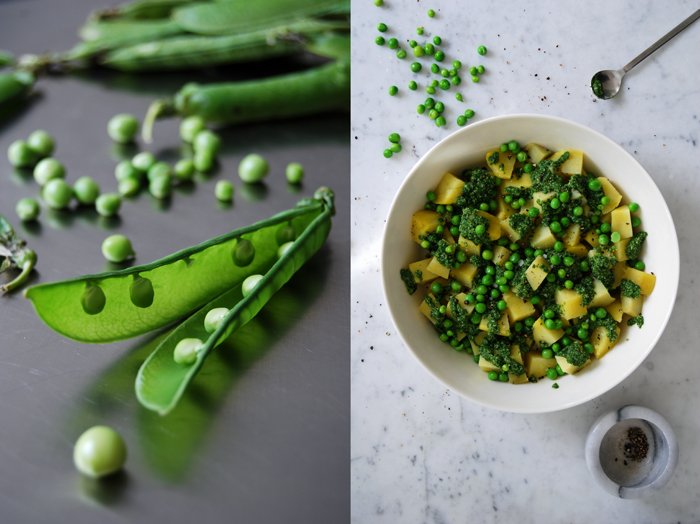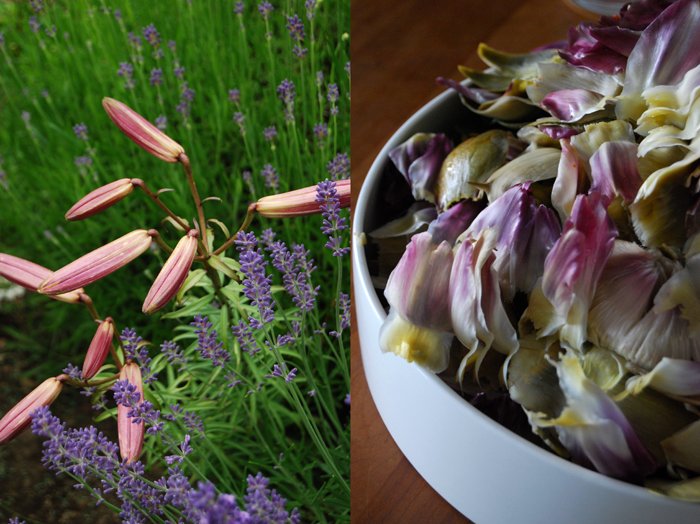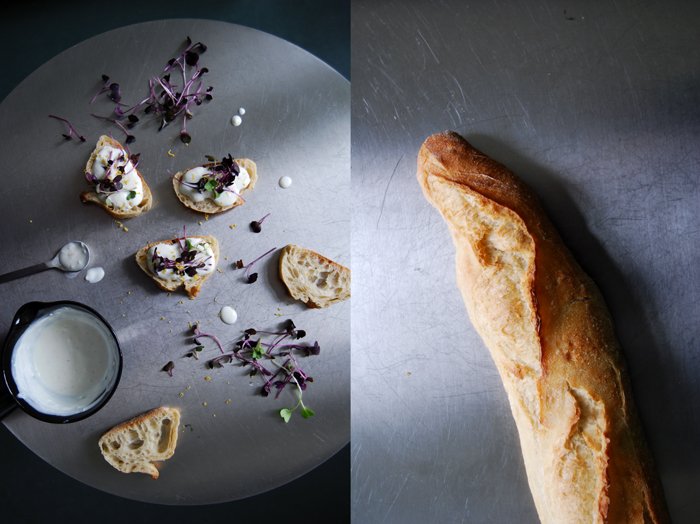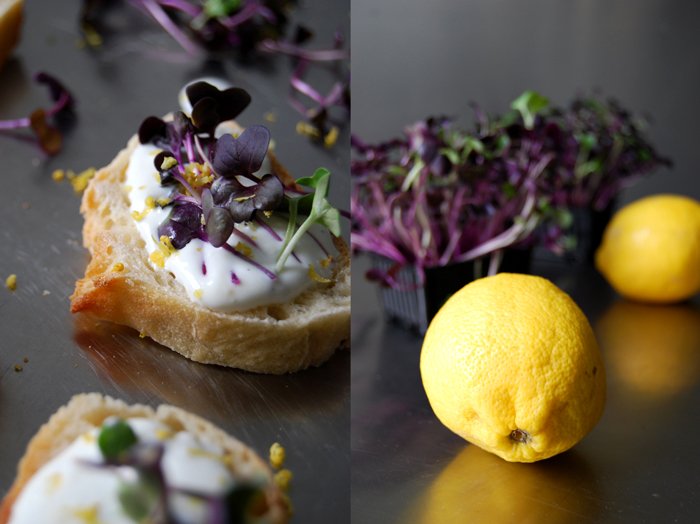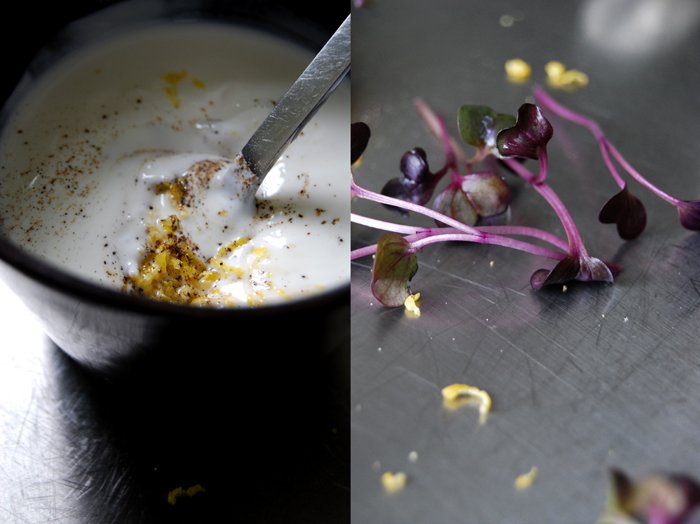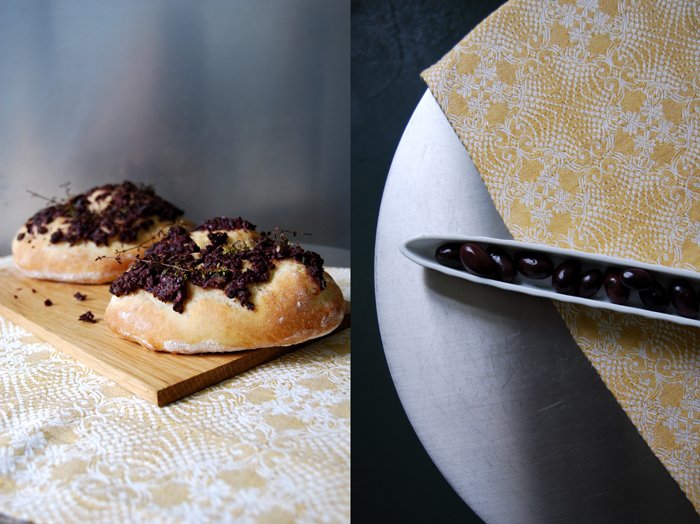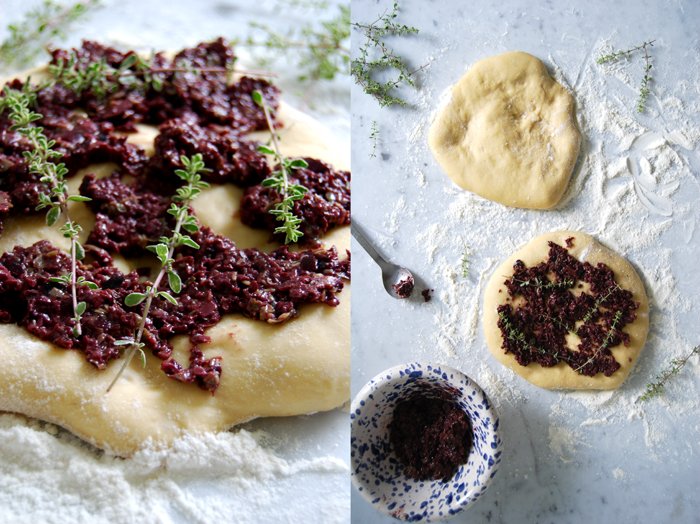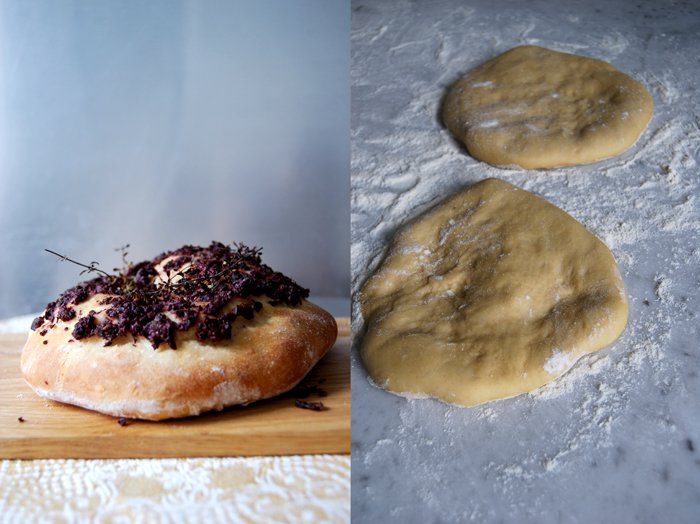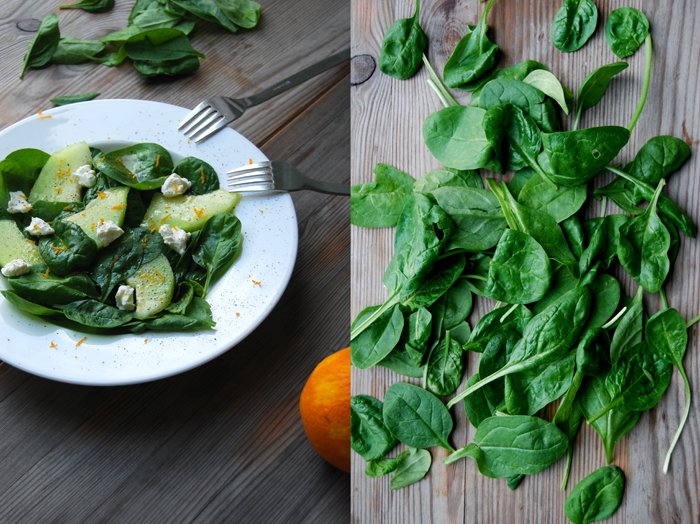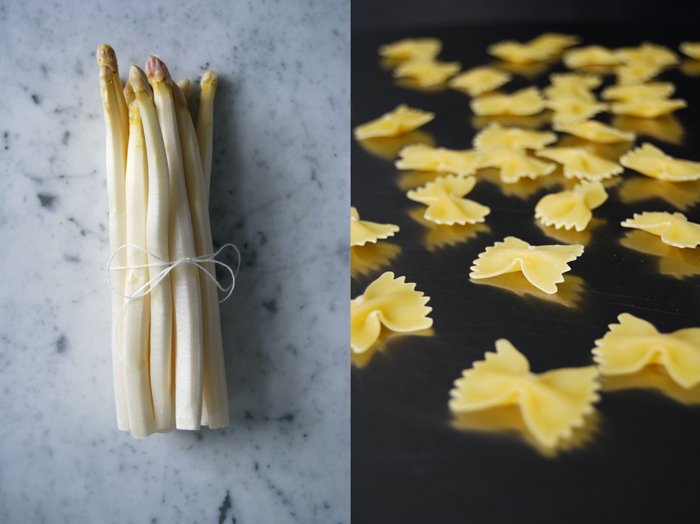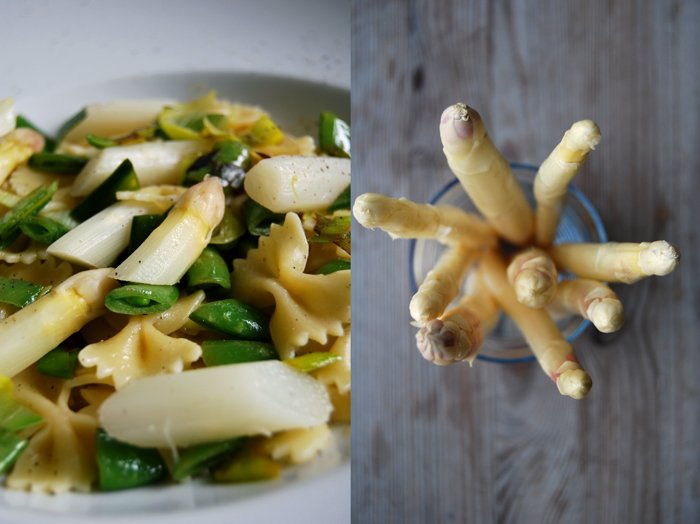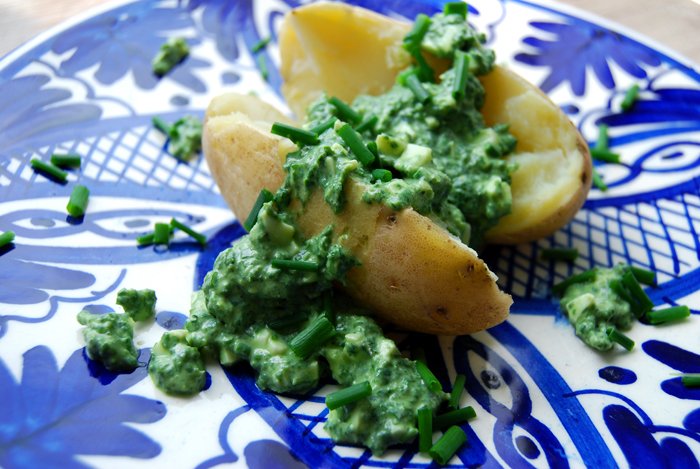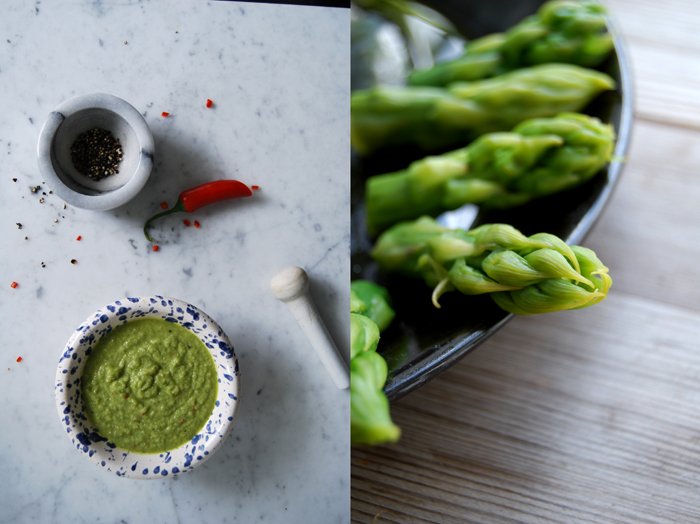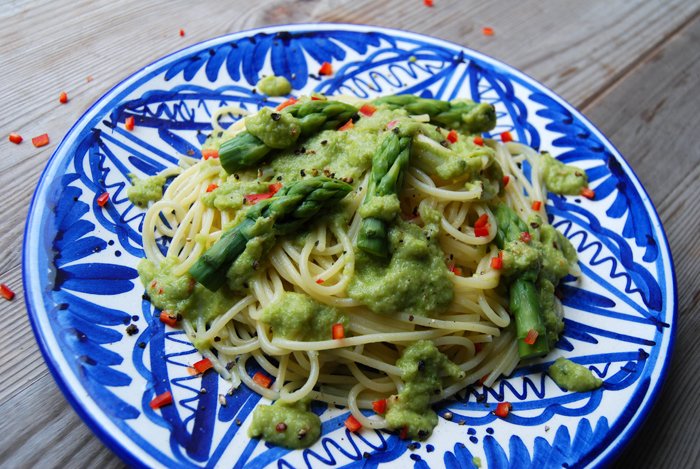Spinach, Strawberry and Goat Cheese Salad with Pink Peppercorns
Green, white and red! Many of my summer dishes sing praise to the Italian flag, without any intention, but maybe my subconscious has something to do with it as I love this country so much. I was so shocked and sad for this football loving nation when they had to leave the World Cup this week (and one of their players got bitten!). I know they love this sport almost as much as their food (which means a lot!), so here's a patriotic salad to lift up their spirits!
Crunchy baby spinach, rucola (rocket salad) mixed with a light olive oil, orange and Balsamico dressing, topped with sweet strawberries, thin slices of young goat gouda and pink peppercorns. The mild Dutch cheese, the berries and aromatic pepper work perfectly on their own as well, cheese, fruit and a little spiciness, a scrumptious little nibble I can never reject!
For this salad for 2 I threw together a handful of baby spinach leaves and a small handful of rucola. My fruity dressing is the same one I used for my spinach and melon salad, I whisked 5 teaspoons of olive oil with 3 teaspoons of orange juice, 2 teaspoons of Balsamico vinegar and seasoned it with a little salt and black pepper. 12 strawberries cut in half and 6 slices of goat gouda (or another mild hard goat cheese) torn in pieces sprinkled on top together with a teaspoon of crushed pink peppercorns finished it off.
Grilled Peach and Camembert Sandwich with Rosemary
It's cheese and fruit again! My last sandwich which combined these two flavours lies more than a month back. I had paired a creamy Gorgonzola with some of the first strawberries of the year, it was mild and milky but spiced up with a few pink peppercorns. Today's sandwich is more intense, I used a ripe Roucoulons camembert from the Franche-Comté region in the East on France. Normally this cheese is quite mild but mine was already beyond that state. It was very ripe, so spicy and sharp that my boyfriend refused to eat it so I decided to put it under the grill. I went for white-fleshed galaxy (or donut) peaches, we call them vineyard peaches in Germany. They are so sweet and juicy, exactly what I needed as the peach season has just begun here and most of the other types aren't rich in flavour yet (and wouldn't have managed the combination with my intense camembert). I sprinkled some crushed black peppercorns on top to add some spiciness and a little fresh rosemary which became a bit smoky under the grill, it was good!
For 6 open sandwiches I used half a loaf of spelt ciabatta cut into thick slices, topped with 2 ripe peaches (sliced) and 125g / 4.5 ounces of Roucoulons camembert. I sprinkled each of them with a couple rosemary needles and put them under the grill for 1 minute until the cheese became a bit runny. We added the crushed pepper afterwards so that each of us could adjust the spiciness.
Potatoes with Rucola Pesto and Peas
A couple vegetables thrown together and mixed with a thick and aromatic pesto, I love these dishes, easy and uncomplicated! You can eat them warm or cold, as a salad, side or main and they are just as perfect on a brunch table as they are for a light dinner with a glass of rosé wine and some crunchy bread. In a month we'll be in Malta and these are the kind of recipes I like to prepare for lunch when the temperature gets closer to 40°C (104°F) and I can feel it slow down the pace of my kitchen activities. You never know how many people will meet at the table, 2, 6 or 8, but a full bowl of potatoes, peas and rucola pesto will please even the biggest Mediterranean family!
This recipe is just as nice with pasta but this time I went for potatoes, the pesto gives them a Southern touch which suits them well. My first idea was to use basil but then I remembered the rucola (rocket) pesto I had made for my Easter lamb chops, so I changed my mind. The rucola adds a soft spiciness, a contrast to the sweet peas. I sprinkled some crushed black pepper on top and my coarse sea salt from Gozo and we ate most of it for lunch, still warm, but the cold leftovers were just as nice!
Potatoes with Rucola Pesto and Peas
For 3 as a main or 4-6 as a side dish you need
potatoes, peeled and cooked, 800g / 28 ounces
peas 100g / 3.5 ounces
coarse sea salt
crushed black peppercorns
For the pesto
rucola (arugula) 80g / 3 ounces
Parmesan 20g / 3/4 ounce
pine nuts 20g / 3/4 ounce
olive oil 75 ml
a pinch of salt
Mix the ingredients for the pesto in a blender.
Cut the potatoes into cubes. Blanch the peas in boiling sugared water for 1 minute and rinse with cold water for 1 second.
In a large bowl, spread out the potatoes and peas and dollop the pesto on top. Sprinkle with sea salt and crushed black pepper.
Artichokes a la Mama with 3 Dips
Here they are, the delicious treats my mother prepared for us when we stayed at her house in the countryside last weekend! I have to leave out the first dinner of the evening we arrived, I was too hungry and exhausted to take any photos after the six hour drive. I got a beautiful aperitif, white wine mixed with Limoncello and mint and I was told to sit down and relax (my family knows that this is not always easy for me to do). So we all gathered in the kitchen, watched my mother cook a fruity tomato sauce with bell peppers and spaghetti, chatted and were happy to be together again!
Today I will share the recipe we enjoyed on the second night, artichokes a la Mama with three kinds of dipping sauces. This is one of her summer classics! She uses big globe artichokes with fleshy leaves, the same kind as those ripening in her garden. It's the first year that she has grown them herself and they look impressive, big plants with a strong stem crowned by a majestic globe, simply stunning! Their leaves are perfect to dip into sauces, there's a lot to nibble on before you finally reach the heart which is thick and tasty once the hairy choke is cut off. My mother always makes a few different sauces, most of the time it's a classic mayonnaise, a smooth tomato dip with black olives, thyme and basil and a yoghurt dressing mixed with hardboiled eggs.
In the next couple of days I will share three more of her recipes with you, one of the best fish soups I have ever eaten, refined with saffron and cooked with king prawns, wolfs fish and cod. Last Saturday we went a bit overboard on the sweet side and we had two desserts in one day, both are so quick to prepare that you can easily make (and eat) them after each other!
Artichokes a la Mama with 3 Dipping Sauces
For 4 people you need
globe artichokes 4
lemon 1/2
Cook the artichokes in lots of salted water together with the lemon for 35-45 minutes (closed with a lid) until you can easily pull off an outer leaf.
For the mayonnaise
My mother whisks the mayonnaise by hand but you could also mix it with a stick mixer in a mug like I did with my aïoli.
organic egg yolks 2
olive oil around 250ml / 8.5 ounces (more or less, depending on the size of the egg yolks)
Dijon mustard to taste
freshly squeezed lemon juice to taste
salt and pepper
Whisk the egg yolks and slowly add the olive oil. Stop adding more oil when the texture is thick (it will take a few minutes) and season with the lemon juice, mustard, salt and pepper to taste.
For the tomato dip
medium tomatoes, finely chopped, 4
black olives, finely chopped, 8
ketchup 3 tablespoons
fresh basil, chopped, 1 tablespoon
thyme leaves of 2-3 sprigs
balsamic vinegar to taste
freshly squeezed lemon juice to taste
salt and pepper
Mix the ingredients with a spoon to a smooth dip and season to taste.
For the yoghurt dip
yoghurt 150g / 5.5 ounces
organic eggs, hardboiled and finely chopped, 3
Dijon mustard to taste
freshly squeezed lemon juice to taste
salt and pepper
chives, snipped, 2 tablespoons
Mix the ingredients (except the chives) with a spoon to a smooth dip and season to taste. Sprinkle with chives.
Lemon Goat Cheese Tartine with Sango Radish Sprouts
Sango radish sprouts! Their deep purple caught my attention and was the initial inspiration for my sandwich, tartine in this case as it's made with a single slice of bread. The colour is mesmerizing, the shades change between a dark violet, almost black, a vibrant green and a dull brown. At home, when I looked at the box with the spouts on my table, the fragile plant reminded me of sea anemones, glowing and a bit unreal. The first bite was more familiar than their look, they taste a bit like pepper cress, spicy and fresh.
A dip just as fresh as the sprouts was my idea for this tartine, in white to achieve a strong contrast to the purple (I couldn't resist to focus on the look of this week's sandwich as well). I'm very much into goat milk products at the moment, soft cheese, hard cheese, cream cheese and yoghurt, the flavour that it adds is strong but never overpowering. This time I went for a light yoghurt and stirred in some cream cheese and mascarpone to give it more texture and creaminess. I bought a rustic baguette which is more juicy and tasty than the normal one, it's almost oily on the inside.
For my dip I whisked 125g / 4.5 ounces of goat milk yoghurt with 1 1/2 tablespoons of cream cheese and 2 tablespoons of mascarpone. To add a bit of tanginess I mixed in 1 teaspoon of freshly squeezed lemon juice, 1 teaspoon of lemon zest and seasoned the creamy dip with salt and pepper to taste. I spread it on 8 slices of baguette and sprinkled the tartines with a handful of Sango radish sprouts ( you could also use pepper or water cress) and a little more lemon zest.
Feta and Tomato stuffed Bell Pepper with Mint
The smell of fresh mint is still in my nose! I spent last weekend at my mother's house in the countryside, more precisely in her garden and kitchen and the smell of herbs and flowers was always around us. She is one of those lucky people who has a green thumb and lots of space to prove it. The strong sun and heavy rain of the past days turned her garden into a blossoming green world with various shades of red, pink, violet and yellow. Whenever I passed her flower and vegetable beds a cloud of roses, thyme, lavender and mint followed me. This was aroma heaven and the the strong mint was a very persistent companion! My mother's vegetable garden made me jealous, artichokes, lettuce, carrots, potatoes, peas and many more, she can honestly compete with my market stands at home! Her herbs grow like weeds, some of them have had their roots in this ground for almost twenty years.
The path from her garden to the kitchen isn't long and we brought lots of these goods inside the house in the past days. We cooked big artichokes with three different kinds of dips, a delicious, light pasta recipe with tomatoes and bell pepper and fish soup. On the sweet side, we had strawberry tarts, ice cream in espresso and I also got to love a great summery aperitif with Limoncello, white wine, lemon rind and mint, needless to say that it was all wonderful and I will write more about it in the coming days.
Back to the fresh mint, here is a recipe so quick to prepare, it looks beautiful and combines a few ingredients which I love for my cooking in summer, bell pepper stuffed with feta, tomatoes, parsley and mint. After twenty minutes in the oven it's done, having four or ten people to feed doesn't make much of a difference, this is a real crowd pleaser!
Feta and Tomato stuffed Bell Pepper with Mint
For 4 people you need
red bell peppers 4
feta cheese, 250g / 9 ounces
medium tomatoes, chopped, 3
parsley, chopped, 3 heaping tablespoons
mint, chopped, 8-10 big leaves
salt and pepper
Set the oven to 200°C / 390°F.
Cut the top off the bell pepper and set aside. Mix the feta, tomatoes and herbs and season with salt and pepper to taste. Fill the bell pepper with the cheese mixture, close the fruit with the lid and put in a baking dish. Bake for 17 minutes, the bell pepper should be al dente.
Spicy Mango Salad and the Thai Park in Berlin
A small path lined with trees and dense bushes led me to one of Berlin's most highly praised culinary hotspots which I've wanted to visit for ages. Last Sunday I finally made my way to the city's famous Thai Park! The air was hot and sticky and I enjoyed the short walk in the shade, I was excited as many of my friends had told me so much about this place and its amazing food. A big meadow surrounded by a green wall of trees opened in front of me, with people sitting on blankets under little umbrellas savoring delicious looking food, playing cards or just daydreaming. It was a peaceful scene, Sunday afternoon calm.
On Sundays when the weather is nice and sunny, women from Thailand, Laos, Vietnam and Indonesia come to the Preußen Park in the heart of Berlin and make it their kitchen. They sit on the grass behind colourful cooling boxes, mobile grills and gas cookers and chop vegetables or fry tempura. While they offer golden fried pork belly, shrimp and dumpling sticks, the ladies chat and laugh between their mobile kitchens. On a tiny patch of grass they cook delicacies which I would hardly manage to create in my kitchen! I was astonished, by the beauty of the food and of the women, the utter satisfaction in their faces touched me. Their passion for cooking and for their traditional recipes is the reason they gather in this park thousands of kilometers away from the recipes' origin to create the meals they grew up with and to share with people like me. I was so impressed by the quality and variety of the dishes they offered!
Needless to say that I bought lots of plates and boxes with salads, meat and fish, spring and summer rolls and dumplings. I found a little spot in the shade and enjoyed all the different dishes, flavours and combinations which I rarely use in my own kitchen. There was far too much food so we enjoyed the leftovers at home where I also came up with the idea for a mango salad with a few changes to the one I enjoyed at the park.
To begin with I didn't have green mangos but a very ripe yellow one which I didn't grate (the traditional way) but cut into slices. I mixed it with lots of coriander, roasted cashews and spicy red chili pepper. For the dressing I used the sesame oil I had bought for my Korean Bibimbap, soya sauce, honey, lime and lemongrass. I didn't try to create an authentic Thai mango salad, it's my own variation on this classic. When I want to eat the traditional one which I won't even try to compete with, I will go to the lady in the park and ask her to prepare a portion for me, the best Thai salad I have ever had!
Spicy Mango Salad with Coriander and Roasted Cashews
For 4 people you need
ripe yellow mangos, sliced, 2
coriander, the leaves of 2 bunches
roasted cashews, chopped, a handful
For the dressing
sesame oil 2 tablespoons
sunflower oil 1 teaspoon
soy sauce 1 teaspoon
honey 1 tablespoon
freshly squeezed lime juice 1 teaspoon
zest of 1/4 lime
red chili pepper, finely chopped, 2.5cm / 1" piece
lemongrass, finely chopped, 2.5cm / 1" piece
a pinch of brown sugar
Whisk the ingredients for the dressing and adjust to taste.
Spread the mango and coriander leaves on 4 plates and sprinkle with the cashews and dressing.
Bruschetta with Avocado, Tomato and Red Onions
Whenever I have some bread leftovers, bruschetta is my solution! White bread doesn't stay fresh for so long, after 1-2 days it becomes a bit hard and dry but some olive oil drizzled on top and a few seconds under the grill will bring it back to life. A fruity dip, dripping and a little oily is the fine finish. I put the topping on just before we eat the bread so that it only soaks a little of the juices and the thin crust stays crisp.
Bruschetta can be the base for all kinds of dips, spreads and vegetables. In late summer I fancy one made with sautéed mushrooms, liver and thyme but luckily we aren't there yet. There's still lots of food in between now and then, lots of vegetables waiting to be chopped and mixed with some olive oil, garlic and herbs to end up on this crunchy bread. I'll start with a mix of velvety avocado, fresh tomatoes and a little spicy red onion.
For the 2 of us, I chopped up a ripe avocado with a fork, roughly, I didn't want to turn it into a mousse. I diced 2 medium sized tomatoes, sweet and ripe, chopped a clove of garlic finely and 1/4 red onion into small cubes. 8 fleshy basil leaves, 2 tablespoons of olive oil, 1 tablespoon of Balsamico vinegar, salt and pepper stirred in made this chunky spread complete. I used a 2 day old baguette for this recipe, sliced and drizzled with a little olive oil, roast under the grill for a minute until it turned golden brown.
Tomato Soup with Goat Cheese Nocken
A few weeks ago I received one of my mother's recipe faxes again. The list of her culinary adventures and recommendations was long (as always) and included Tyrolean Nocken made of goat cream cheese mixed with finely chopped hard mountain cheese. Nocken are dumplings, they can be made of potatoes like Italian gnocchi, bread or flour but there is also an uncooked version in which case they are made of cream cheese or ricotta. I've made these a couple times but never mixed with hard cheese. This sounded interesting, especially because I've been wanting to make tomato soup for weeks which seemed like the perfect combination to me. The fruity soup, thick and sweet, refined with some strong goat milk and cheese flavours!
I slipped in some herbs as well, fresh basil for the tomatoes after the soup was done and chives for the Nocken. The soup is a strong concentrate of 2 pounds of tomatoes, chopped and cooked with skin and seeds for just 10 minutes. Some garlic rubbed with salt to a smooth paste, a tiny bit of broth, some vinegar and the basil, that's all it needed. Apart from the Nocken, which I scooped with a wet spoon, to place a white dot in the middle of a glowing red bowl!
I served the tomato soup warm, some prefer it cold but that's not really my thing.
Tomato Soup with Basil and Goat Cheese Nocken
For 2 people as a main or 4 as a starter you need
ripe tomatoes, chopped, 1 kg / 2 pounds
broth 125ml / 5 ounces
garlic 2 big cloves
balsamic vinegar 1 tablespoon plus more to taste
a pinch of sugar
fresh basil leaves, roughly chopped, a small handful
salt and pepper
olive oil for frying
For the Nocken
fresh goat cream cheese 125g / 4.5 ounces
hard mountain cheese (like Appenzeller or Gruyère), finely chopped, 20g / 1 ounce
chives, snipped, 1-2 tablespoons
salt and pepper
Rub the garlic with 1/4 teaspoon of salt under a big knife to a smooth paste.
In a big pot, heat a splash of olive oil, add the garlic paste and tomatoes and cook for 4 minutes on medium temperature (open). Add the broth, vinegar, sugar, salt and pepper and cook for 5 minutes (open). Take off the heat and purée with a stick mixer or in a blender. Season with salt, pepper and vinegar to taste and stir in the basil.
Mix the goat cream cheese, hard mountain cheese and chives, season with salt and pepper to taste. With a wet tablespoon form oval Nocken and place on top of the soup. Serve immediately.
Sicilian Sfincione with Tapenade
Forget thin and crisp, this pizza is thick and juicy! The Sicilian Sfincione is more like a focaccia, the dough is made with eggs and milk which gives it a bit of a sweet bread feeling. Its origin dates back to the late Baroque when the aristocratic Sicilian families liked to employ French chefs, the "Monzu" coming from the French Monsieur, some of them became famous Sicilian chefs. Here's the beauty of culinary exchange between two cultures, they influence each other, they don't confine each other but merge and evolve! If only cultural exchange was always so easy and well received!
In the beginning of the 18th century, these chefs started to influence Sicilian cuisine and left quite a few marks in the kitchen, also in the making of pizza. Eggs and milk, sometimes even butter, found their way into this famous dish and created completely different textures and tastes, like the popular Sfincione.
As there is already a French touch involved I thought I might as well continue working with it in the topping. I went for a rich Provençal tapenade made of lots of black olives, capers, anchovies, olive oil, brandy and lemon juice topped with thyme sprigs. It was great! This pizza is perfect for a picnic, as a starter or with a salad on the side. I love pizza, so much that I bake it every Sunday and this Sicilian variation is definitely a summer favourite!
Sfincione with Tapenade
For 4 Sfincione (15cm / 6") you need
For the dough
plain flour 500g / 1 pound
dry yeast 1 package (for 500g / 1 pound of flour)
salt 1/2 teaspoon
organic egg 1milk, lukewarm, 250ml / 8.5 ounces
Combine the flour with the yeast and salt, add the lukewarm milk and egg and mix with your dough hooks for a few minutes. Continue kneading and punching with your hands until you have an elastic dough ball and put it back in the bowl. Cover with a tea towel and let it rise in a 35°C / 95°F warm ( top / bottom heat, no fan!) oven for 45 minutes.
Divide the dough into 4, stretch into thick 15cm / 6" disks on a floured surface and cover with a kitchen towel. Let them rise while you continue the preparation for the tapenade.
For the tapenade
black olives 200g / 7 ounces
capers 40
anchovy, rinsed and dried, 2 fillets
olive oil 2 tablespoons plus more for sprinkling
brandy (or cognac) 2 tablespoons
freshly squeezed lemon juice 2 tablespoons
mustard 1 teaspoon
pepper
thyme 16 small sprigs for topping
Mix the ingredients for the tapenade in a blender and season with pepper to taste.
The Sfincione
Set the oven to 250°C / 480°F, my oven has a special pizza setting but you can use top / bottom heat as well. Line a baking sheet with parchment paper.
Spread a quarter of the tapenade on each pizza, put 4 thyme sprigs on top of each and bake for 6 minutes or until golden brown. Sprinkle with olive oil immediately and serve warm or cold.
Spinach and Melon Salad with Orange Mascarpone
Crisp, young spinach leaves, sweet and ripe Galia melon, creamy mascarpone and a little orange zest becomes a delicious sweet and savory summer salad! It sounds a bit more exotic than it tastes, it's a very fresh and harmonious combination. The idea for it was born out of another recipe which didn't work out as I had expected. I felt like a salad made with melon and a milky flavour. At first, I mixed the melon with mozzarella di bufala but the result wasn't quite as pleasing as expected so I looked for another possible use for my juicy fruit. Spinach, mascarpone and orange, my second attempt was more successful and finally I was satisfied with my salad.
I just wanted a quick and light lunch so I spread a big handful of young spinach leaves on 2 plates together with a quarter Galia melon cut into wedges. I mixed 2 tablespoons of mascarpone with a little freshly squeezed orange juice and dolloped little pieces of it on top of the salad. For the dressing I whisked 5 teaspoons of olive oil with 3 teaspoons of orange juice, 2 teaspoons of balsamic vinegar and a little salt and pepper. I sprinkled the dressing on top of the leaves and fruit and finished it off with 1/2 a teaspoon of orange zest.
Sometimes you have to give your ideas a second try, change them a little but then you'll be rewarded. It definitely won't be the last time I make this salad!
Saffron Bread
Here's the saffron bread I promised!
Let's start with the texture, it's juicy but light, a quality I love of all of my bread recipes, be it my Zucchini Bread, the Olive Loaf or my Potato Bread, but this one has a special aroma. It's made with one of the most precious and expensive spices, dried saffron threads. Only a very small part of the saffron crocus' flower is used for the production of this red spice, the three crimson stigmas growing at the end of the carpel. Lots of flowers, 150 - 200, are necessary to produce 1 gram of this treasure! Luckily, its aroma is so intense that a tiny amount is enough to refine other ingredients with its flavour.
For my bread made of a bit more than a pound of flour I used a pinch of saffron threads (around 1/5 teaspoon) to spread their unique taste. At first I was a bit worried that it wouldn't be strong enough for yesterday's sandwich, the Greek feta dip mixed with harissa and cayenne pepper had quite an impact of different flavours. To my surprise, the hot spiciness and the saffron complemented each other perfectly! It was a Greek reunion as antique mythology tells that the Greek God Zeus used to sleep on a bed covered in saffron.
Saffron Bread
For 1 big loaf of bread you need
plain flour 550g / 19 ounces
yeast 1 package (for 500g / 1 pound of flour)
salt 1 1/2 teaspoons
water, lukewarm, 230ml / 8 ounces
olive oil 4 tablespoons
a pinch of saffron threads (around 1/5 teaspoon)
Mix the saffron with 3 teaspoons of the water.
In a large bowl, combine the dry ingredients, add the olive oil, saffron liquid and the rest of the water and mix with your dough hooks for 5 minutes until well combined. Continue kneading with your hands for around 5 minutes until you have an elastic dough ball. Put the dough back into the bowl and cover with a tea towel. Let the dough rise in a 35°C / 95°F warm ( top / bottom heat, no fan!) oven for 60 minutes.
Take the dough out, punch it down and knead for 1 minute. Form 1 long loaf and put on a baking sheet lined with parchment paper. Cover with a tea towel and let it rise for 25 minutes in a warm place.
Set the oven to 225°C / 440°F.
Cut 4 diagonal slashes into the bread and bake for 20 minutes or until cooked through. If you’re not sure if it’s done turn the bread around and knock on its underside, it should sound hollow. Let it cool for a couple minutes on a wire rack covered with a tea towel to soften the crust a bit.
A Greek Feta Dip with Harissa and Cayenne Pepper on Saffron Bread
The Greek stand at the market pokes my weak spot for spreads and nibbles. Bowls full of stuffed vine leaves, bean salad, olives, dips and feta cheese in all kinds of variations, I could always buy a box of each of these delicacies and line them up on my long dining table. Together with some fluffy flatbread and a glass of red wine, this is as good as a holiday!
As much as I enjoy the convenience of just going there and choosing whatever my taste buds feel like, I also like to make my own feta dip with herbs, spices or olives. This time I go for a spicy spread with harissa, cayenne pepper and some fresh red chili peppers. It's accompanied by my wonderful loaf of saffron bread which I baked especially for this dip as I know and love its sandwich qualities. This yellow spice is strong but not overpowering and always manages to bring in its special flavour. The bread is very aromatic, spongy, juicy, it's so good that it doesn't really need a topping, some olive oil sprinkled on top is already heavenly. I could have left it at that but I like the combination of saffron and harissa, there wouldn't be a better bread for my dip, not even a greek flatbread from the market.
Tomorrow I will share the recipe for the saffron bread with you but here's my Greek feta dip with harissa and cayenne pepper (which tastes as good on any other tasty, fresh bread):
Mix 200g / 7 ounces of Greek feta cheese crumbled with a fork with 100g / 3.5 ounces of cream cheese, 4 tablespoons of olive oil and 1 tablespoon of heavy cream. Add 2 teaspoons of dry harissa spice mix and a pinch of cayenne pepper (or more if you like it hot and spicy) and whip with a fork. I didn't add any salt as the cheese makes it salty enough. Sprinkle with finely chopped fresh red chili pepper and some olive oil and spread voluptuously on a thick slice of bread. This dip is enough for 4 people as a starter, the 2 of us emptied the bowl in 2 days. It would be great for a picnic or barbecue as well!
Farfalle with Asparagus, Peas and Leek in Mustard Sauce
This is one of my oldest, most beloved and often cooked spring/ summer recipes. It's been with me for so many years and I still savour it as I did the first time I cooked it. It works both warm as a comfy pasta dinner with a glass of rosé wine, the windows wide open and the flowery smell of June in the air but also as a cold, summery picnic salad, enjoyed outside in the fields under the rustling leaves of a swaying tree.
I'm talking about the wonderful combination of the fine flavours of white asparagus together with sweet peas in their crunchy pods, leek and a light sauce made with spicy Dijon mustard. All this on top of a big bowl of pretty Farfalle pasta, little bow-ties of perfect size and shape to catch all these nice vegetables like a shovel!
This meal tastes fresh and light and is absolutely easy to prepare. You just need to cook the asparagus (green or white), sautée the young pea pods and leek (you could also blanch some peas), deglaze them with white wine or vermouth and mix everything together with the cooked pasta, some mustard and cooking liquid, salt and pepper - that's it!
Farfalle with Asparagus, Peas and Leek in Mustard Sauce
For 2 people you need
Farfalle pasta, 200g / 7 ounces
asparagus (white or green), peeled (if necessary), bottoms cut off, 500g / 1 pound
young peas in their pods, cut into bite sized pieces, 150g / 5.5 ounces
leek, cut into slices, 1/2
water used to cook the asparagus 150ml / 5 ounces
Dijon mustard 2 teaspoons plus more to taste
white wine or vermouth for deglazing
salt and pepper
olive oil for frying
Cook the pasta al dente in lots of salted water.
Cook the asparagus al dente in lots of salted water with a pinch of sugar and cut into bite sized pieces.
In a large heavy pan, heat a splash of olive oil and fry the leek for a few minutes until soft and golden, add the pea pods and fry for another 1-2 minutes. Deglaze with a splash of wine, add the pasta, mustard and water used to cook the asparagus. Season with salt and pepper, add the cooked asparagus, mix and serve on big plates.
Juicy Zucchini Steaks with Dried Tomatoes, Sage and Chèvre
When I went to the market on Saturday I bought one of my favourite goat cheeses from a tiny stand run by a sweet lady who produces her own cheese. She just uses goat milk for her products and her display offers delicious soft chèvre rolls and creamy cheese balls coated in spices and herbs, with chili, herbes de provence, rosemary and basil. These soft cheeses are her absolute speciality, mild and milky with a soft hint of goat milk.
I planned to buy a plain cheese roll but a beautiful white chèvre covered in parsley leaves and pansy flowers caught my attention. The lady explained to me that it's filled with dried tomatoes, I was currious and forgot about my plain cheese immediately. I tried it, liked it and bought it! My plans for dinner involved golden sautéed zucchini cut into thick round steaks, juicy inside but far away from soft and soggy, topped with fresh goat cheese and sage. My find at the market inspired me to add some dried tomatoes, it was a good choice, the Mediterranean flavours were great together with the mild goat milk!
Zucchini Steaks with Dried Tomatoes, Sage and Chèvre
For 2 people you need
zucchini, cut into 1,5cm / 1/2" steaks, 300g / 10.5 ounces
garlic, thinly sliced, 1 clove
chèvre/ soft goat cheese, thickly sliced, 70g / 2.5 ounces
dried tomatoes, cooked in a little boiling water for 1 min, rinsed, dried and chopped, 1 1/2 -2
sage leaves, thinly sliced, 5
olive oil for frying
salt and pepper
In a large pan, heat a splash of olive oil together with the garlic and fry the zucchini on high-medium temperature for a few minutes until golden brown on each side. Add the cooked dried tomatoes and sage, season with salt and pepper and fry for 1 minute. On a plate, pile the zucchini steaks on top of each other and let them sit for 1 minute, that makes them a bit softer and juicy. Spread them on a big plate and place the chèvre on top of the warm zucchini and sprinkle with the dried tomatoes and sage from the pan.
Frankfurt Green Sauce - 7 Herbs and Spring Potatoes
Sorrel, borage, chervil, burnet, parsley, chives and garden cress, these are the 7 herbs which make up the traditional Frankfurt Green Sauce. Similar to the Italian Salsa Verde or the French Sauce Verte, which are also mainly made of herbs, the famous German version is made of greens growing in the Frankfurt area. Legend has it that the origin of the green herbal sauce is in the Orient and it was brought to Europe by the Romans more than 2000 years ago, enough time for each region to create their own, unique recipes. Apart from the right selection of herbs, there isn't "one" recipe for this sauce from Frankfurt. They all vary, some add heavy cream, sour cream, yoghurt or mayonnaise, some are made with onions, garlic or mustard, but most involve a hard boiled egg.
I developed my own recipe a few years ago when I used to live close to the city of the sauce's origin. To me, the sauce needs 2 crumbled hard boiled eggs, sour cream, olive oil, lemon juice, a little heavy cream for some sweetness, white Balsamico vinegar and salt and pepper, but the focus is definitely on the herbs, you need a lot, 200g / 7 ounces in total!
Traditionally the cold sauce is eaten with boiled spring potatoes, some serve it with cold meat but I prefer to keep it simple and light, the sauce is so fragrant and aromatic that the mild potatoes fit just perfectly.
Frankfurt Green Sauce with Spring Potatoes
For 2-3 people you need
medium sized potatoes, boiled and peeled, 4-6
For the sauce
mixed herbs (sorrel, borage, chervil, burnet, parsley, chives and garden cress) 200g / 7 ounces
organic eggs, hardboiled, chopped finely, 2
sour cream 5 tablespoons
olive oil 2 tablespoons
freshly squeezed lemon juice 2 tablespoons
heavy cream 1 tablespoon
white balsamic vinegar 1 tablespoon
salt and pepper
Chop the herbs with a knife finely or mix in a blender. Put the herbs in a big bowl and add the eggs, sour cream, heavy cream, olive oil, lemon juice and vinegar and stir until combined. Season with salt and pepper to taste and serve on top of the potatoes.
Kalamata Olive and Cottage Cheese Sandwich
Creamy cottage cheese mixed with dark purple Kalamata olives, garlic, herbs, Balsamico vinegar, that's what I had in mind when I started my sandwich preparations. My plan changed abruptly as soon as I stirred the chopped olives into the crumbly cottage cheese, I stopped turning the spoon before the oily black mixture blended into the creamy white, the contrast looked so beautiful! I tried some of this puristic spread and I was so impressed by its intensity and simplicity that I dropped everything. This combination is too good, Kalamata olives (to me, they are the best black olives in the world!) plus cottage cheese, no distraction, no further addition, just a few slices of fresh baguette and one parsley leaf on top, that's all it needs! This is the quickest and most simple recipe I've made so far for my Sandwich Wednesday and it's already one of my favourite sandwiches!
If you're looking for a quick snack, a picnic treat, an easy dinner or just a nibble with some crackers, pull out some cottage cheese (200g / 7 ounces) and mix briefly with 50g / 2 ounces (or more) of chopped Kalamata olives. You could use other black olives as well but the large Greek fruits from the Peloponnese region have a wonderful aroma, exactly what you need if you mix only two ingredients. I didn't want to over mix it, I only stirred it twice before I spread the cheese on tiny slices of baguette. The green fleshy parsley leaves on top finished it off and added a fresh taste to this composition. I loved it so much that I ate one slice after the other, it was just enough for 2!
Zucchini, Bell Pepper and Aubergine Moussaka with Lemon Ricotta
My Moussaka, truth be told, is a fruity ratatouille baked with a fluffy lemon ricotta soufflé on top. The traditional Greek Moussaka is made with a Béchamel sauce which I'm not too fond of. I like this creamy sauce in my lasagna or cannelloni but that's it. The ricotta tastes much lighter, enhanced with lemon zest, nutmeg, parmesan and fresh basil, it gives this dish more of a summer feeling. Contrary to the Greek version, I kept mine vegetarian, there's no minced meat involved, just zucchini, bell pepper, tomatoes, red onions, lots of parsley and a velvety layer of fried aubergine slices in between the vegetables and the cheese. It stops the ricotta from running into the juicy ratatouille.
When I cook a ratatouille I always make a big batch. This moussaka is perfect as a second day dish for ratatouille leftovers. Topped with the ricotta it just has to bake in the oven for half an hour, great if you have friend's over for dinner and not much time for preparations! I baked it in small casserole dishes closed with a lid so that each of us could have our own little pot.
Zucchini, Bell Pepper and Aubergine Moussaka with Lemon Ricotta
I bake the Moussaka in two 12,5cm / 5" casserole dishes with lids, you could use a big one instead but you may have to bake it a bit longer for the ricotta to set.
For 2-3 people you need
small aubergine, sliced into circles, 1
zucchini, sliced into circles, 1
red bell pepper, thinly sliced, 1
big red onion, quartered and thinly sliced, 1
big tomatoes, chopped, 4
garlic, thinly sliced, 3 cloves
parsley, chopped, 2 tablespoons
balsamic vinegar 2 tablespoons plus more to taste
olive oil for frying
salt and black pepper
For the topping
ricotta 260g / 9 ounces
organic eggs 2
Parmesan, grated, 30g / 1 ounce
small basil leaves, chopped, 30
lemon zest 1 teaspoon
lemon juice 1 teaspoon plus more to taste (I also added a little of the liquid of my Moroccan preserved lemons)
nutmeg, ground
salt and pepper
Spread the slices of aubergine on a baking dish and sprinkle with salt on both sides to pull some of its water out. Let it sit for around 15 minutes, rinse the slices and dry between kitchen roll paper. In a large heavy pan, heat a splash of olive oil and fry the aubergine for a few minutes on both sides on medium temperature until golden and soft, add a little more oil if necessary. Season with salt and pepper and set aside.
In a large pot, heat a splash of olive oil and fry the onion for a few minutes until golden and soft. Add the bell pepper and garlic and fry for 2 minutes before you add the zucchini. Fry the vegetables for 2-3 minutes and deglaze with 2 tablespoons of balsamic vinegar. Add the tomatoes, season with salt and pepper and cook for 10 minutes. Add the parsley and season with balsamic vinegar, salt and pepper to taste.For the topping, mix the ricotta, eggs, parmesan, basil, lemon zest and juice and season with nutmeg, salt and pepper to taste.
Set the oven to 200°C / 390°F top/ bottom heat.
Divide the vegetables between the 2 casserole dishes, cover with 3-4 slices of aubergine and spread the ricotta mixture gently on top. Cover with lids and bake for around 35 minutes until the ricotta mixture is set.
Spaghetti with Green Asparagus Anchovy Pesto
Asparagus season could be extended for months if it were up to me! So many recipes bring out different sides of this vegetable, be it green or white asparagus, it's so versatile thanks to its strong taste.
So here’s an asparagus pesto, light and fresh with a smooth texture, almost velvety. The preparation is the same as the broccoli pesto I made in March, the cooked vegetables are mixed with some of the water they are cooked in. I added garlic, fresh hot chili peppers, tarragon (my herb of the month) and anchovies. The fish adds subtle saltiness, which really makes this composition complete. I once made this pesto without the fish as I had run out and it really wasn't as good. I use 4 anchovies for 500g (1 pound) of asparagus, I originally started with just 2 when I made it the first time. I thought they would be too strong for the pesto but sometimes in cooking you shouldn't be shy, being bold and brave is the key to success!
For more asparagus recipes, click here!
Spaghetti with Green Asparagus Pesto and Chili Peppers
For this meal it’s best to warm up the plates in the oven.
For 2 hungry people you need
spaghetti 200g / 7 ounces
green asparagus, the woody bottom part cut off, 500g / 1 pound
water used to cook the asparagus 30ml / 2 tablespoons
olive oil 60ml / 1/4 cup
freshly squeezed lemon juice 1 tablespoon
anchovy preserved in salt, rinsed and dried, 4 fillets
garlic, crushed, 3 cloves
tarragon 12 leaves
fresh red chili pepper, finely chopped, 1, half for the pesto the rest for topping
salt and pepper
Cook the spaghetti al dente.
In a large pot, cook the asparagus in lots of salted water for 7 minutes. Keep the water, take the asparagus out with a slotted ladle and cut into 3cm / 1″ pieces. Set the heads aside and leave for the topping.
Purée all the ingredients for the pesto in a blender (except the asparagus' heads and the chili peppers for the topping). Season with salt (carefully, I didn't need to add any because of the salty fish), pepper and lemon juice to taste.
Arrange the spaghetti, pesto and asparagus' heads on the warm plates and sprinkle with chili and crushed black pepper.
Aïoli and Wild Herbs Sandwich
When I went to Ibiza for the first time I got absolutely hooked on aïoli, I ate it every single day! It's more than twenty years ago and I had just turned thirteen. I was so happy to spend some time with my best friend at her parent's holiday home, it felt exciting to be on this island which is so famous for its parties (which I couldn't join as I was still too young)! I especially enjoyed the nights out at all the amazing restaurants we visited together, I have always loved Spanish food, tapas and barbecues, but in those days I was particularly fond of Ibiza's traditional appetizer, fresh bread and aïoli. In Spain, people usually go to restaurants quite late, at 9 or 10 in the evening, by that time I was already starving. As soon as we sat down and a basket full of warm bread and a bowl of creamy aïoli was brought to the table, nothing could stop me from emptying both!
It took me a while to make my own aïoli, a few years ago we had friends over from Barcelona and they introduced me to the traditional dip's secrets. It's surprisingly quick and easy to prepare:
For 4 sandwiches you drop 2 egg yolks into a mug which should be just big enough for a stick mixer to fit in it. You mix 3 crushed cloves of garlic with 4 teaspoons of freshly squeezed lemon juice in one bowl, and measure 100ml / 3.5 ounces of good quality olive oil in another. Pour 1/4 of the oil onto the egg yolks and start mixing with the stick mixer, add more oil and the lemon garlic mixture, a little at a time, mixing constantly. When the dip is thick and creamy season with salt. Spread on 4 thick slices of white bread and sprinkle with mixed wild herbs. I found a fantastic mixture of wild herbs which I don't use often, saltbush (orache), burnet, rucola, pigweed, edible chrysanthemum, yarrow, cheeseweed and chickweed. Every bite brought in new flavours, all strong and delicious together with the aïoli!












